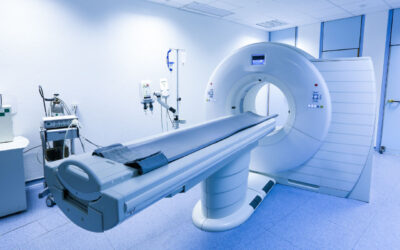By Matt Skoufalos

Photo: Courtesy of PrinterPrezz, Inc. | Scanner pictured: HP Sprout
Since the introduction of commercially available 3D printers, the technology has been largely celebrated for its adoption by makerspaces, as an introductory method of teaching computing to children or as a novelty gift for gadget lovers. In the industrial space, however, the technology has grown by leaps and bounds in its applications for prototyping and manufacturing. Now that same enthusiasm has reached the health care industry, where imaging-guided surgeons are turning its focus to myriad uses.
Dr. Huie Lin directs the Adult Congenital Heart Program at Houston Methodist Debakey Heart and Vascular Center in Houston, Texas. An interventional cardiologist, Lin sees patients through the multiple procedures required to correct pediatric congenital heart defects all the way into adulthood. The bulk of that work is done through trans-catheter interventions, which Lin described as having become critical to the management of these issues.
“Every single heart is a little bit different,” and so are the surgeons who may operate on them in the repeat procedures his patients undergo as they age and develop, Lin said. Aside from structural differences in their organs, patients react differently to the different procedures they’ve undergone, which are likewise a byproduct of the different surgeons who’ve conducted them. Their treatment relies on the sophisticated imaging that drives surgical planning, and physicians “need the third dimension to take care of them correctly,” Lin said.
“There’s no imaging we can do that’s 3D on the [operating] table,” he said. “But being able to pre-plan the case with stereoscopic [imaging] is critical.”
The three-dimensional visualization that physicians can get from reconstructed CT, MR, and similar images of the patient’s heart, whether viewed through virtual-reality goggles or a 3D television, helps doctors to better understand the specific cardiovascular structures of the hearts on which they operate, and how those are related to each other. At Houston Methodist, the process starts when that imaging data of the patient’s heart is shipped off to engineers who can model it and send it off to a 3D printer.
“It’s a lot of elbow grease,” Lin said. “You have to have a scientist do the data modeling to have a data set that you can send to the 3D printer. That’s the cognitive element that’s very painstaking; we’ve had a couple of fantastic engineers who’ve done that for us.”
The next step in the process takes place at 3DPTX, a Houston-based “3D printing service bureau” that produces a patient-specific model of the heart with PolyJet 3D printers. Similar in design to inkjet paper printers, the PolyJet printer layers liquid photopolymer onto a build tray; when the polymer is exposed to light, it hardens into whatever shape it’s programmed to take.
The technology is precise enough to produce models that are specific to patients’ anatomies, and can include colored cross-sections to identify different tissue in the heart. Doctors like Lin then use the models to preview trans-catheter procedures, and to select and test-fit implantable devices before they go to work inside the patient. That saves time, effort, and can pre-empt complications that may have previously been unforeseen without the imaging-powered test run.
“We’ve taken a combination of trans-catheter devices and an open surgical technique to reduce the use of the bypass machine,” Lin said. “That’s been really powerful. We’re taking [implantable devices] that are off the shelf, and making sure they don’t impinge on other cardiovascular structures. Then we’ll implant it, and make sure it’ll actually work [using the 3D model].”
Lin recalls a case in which the 3D modeling process helped a complicated patient to undergo a successful operation. The 63-year-old had gone through his life with an undiagnosed heart defect that created “severe volume overload,” sending blood flowing from one side of his heart to the other. Typically, the surgeon would have patched it from one side of the heart to another; with the 3D modeling technology, “we started coming up with a different way of approaching it” Lin said.
Using the patient’s heart model, they sourced a stent graft that covered the hole in the left atrium of his heart while also allowing anomalous veins within to drain back into his left atrium normally. The information they gleaned from the trial run with the 3D-modeled heart helped Lin’s team significantly.
“I see this as shifting the paradigm of how you think about treating patients,” Lin said. “To some extent in medicine, there’s a lot of ‘I’ve got this drug,’ or ‘I’ve got this valve; let’s try it and see if it works.’ [3D modeling] lends people like me a lot more confidence in the treatment.”
Likewise, Lin said 3D modeling allows physicians to explore “edgy things in patients who wouldn’t otherwise have any hope” of a solution to their problems.
The modeling approach has also helped the center determine whether it could help prospective patients who didn’t live near their Houston facility. By importing their imaging studies to 3DPTX, where their hearts would be printed, teams at Houston Methodist could examine the models to determine if treatment was possible before inviting people to travel to them. Of course, without the cooperation of agencies like 3DPTX and the Texas Medical Center accelerator, the modeling process wouldn’t be feasible, Lin said. Without a reimbursement mechanism to cover the cost of the work involved, physicians must consider innovative approaches to funding the process.
“Right now, there’s no mechanism for the health care industry to say, ‘You spent this many hours, and that went into the planning for this procedure,’” Lin said. “Right now, the next thing to happen in this field is for [3D modeling] to become part of the cost structure. Part of the problem is defining that cost structure.”
Lin believes the potential patient base for 3D-modeling-guided procedures is limitless; it just requires the alignment of the right staff and institutions to promote it.
“Patients and hospitals and technology vendors and scientists can get together; it’s almost shovel-ready,” he said. “There needs to be a way to pay for it so nobody gets excluded from that option.”
Already, there has been some movement on that front. In November 2018, the American Medical Association (AMA) CPT editorial panel accepted a proposed Category III code for 3D anatomic modeling. Put forth by the American College of Radiology (ACR), that code will be effective July 1, 2019.
Although a Category III code does not guarantee reimbursement for a procedure (only a Category I code does that), the classification supports physicians lobbying their state agencies for its advancement, said Michael Gaisford, director of marketing for healthcare solutions at Stratasys of Eden Prairie, Minnesota.
“There is huge economic incentive and alignment to using 3D printing in a hospital,” Gaisford said. “We need continued engagement with clinicians and continued development of these applications to codify the techniques that generate the most valuable models, and then communicate them to the physician community.”
“There’s so many different aspects where it intersects with health care,” he said.
Stratasys manufactures the PolyJet printers used at 3DPTX; the technology therein is used for a variety of medical applications, from anatomical modeling to biological printing to implantable devices. In addition to creating patient-specific, imaging-based modeling for procedural planning, Gaisford believes 3D-printing technologies can support surgeons by building a cutting guide from the negative images of patients’ anatomies. Doing so creates a product that he said produces an optimal surgical cut.
“These models become great tools for education training,” Gaisford said; “you pick the model that’s designed to treat a complex case, and you can use that same model to train your residents and fellows so they can practice performing a procedure on a non-patient model.”
3D-printed anatomical models are also used for selecting hardware to be used in plastic surgery, creating apparatus that more symmetrically fit patients, and pre-bending plates instead of doing that reconstructive work during the procedure itself. They can likewise be used in surgical oncology to reproduce patients’ organs to display tumors alongside healthy vascular and nervous tissue, all segmented in different colors.
Gaisford said these models also help improve communication with patients’ families — “here’s your child’s heart, your loved one’s kidney tumor, and here’s how we’re going to approach it” — as well as educating surgical teams.
“We say a picture is worth a thousand words; a 3D-printed model is worth a million words,” he said. “You’re interacting with the physical space in a way you can’t do virtually or in two dimensions.”
Some of the wait times from scanning to modeling can even be cut back via advanced visualization systems with which some imaging devices are presently equipped, Gaisford said. Models sold by Philips, GE and Vital Images (Canon) can output a 3D-printable file from the software packages on their workstations. A variety of third-party and open-source solutions are available, but Stratasys printers are integrated with Materialise Mimics imPrint, an application that translates DICOM raw data into a format usable by 3D printers. Gaisford said the combination of technologies is part of an FDA-cleared process for creating 3D-printed models for diagnostic purposes.
“Many radiologists and clinicians aren’t aware of that feature,” he said.
Gaisford also believes that as 3D printing becomes more common in hospital environments, the wait time from scan to print will decrease. Lin cited a 24- to 36-hour turnaround for models at Houston Methodist, but Gaisford believes procedure-specific modeling can cut that time down to a next-day delivery in some instances, lowering costs as well.
“When I talk to customers that have adopted 3D printing as a very common tool within certain procedures, then the learning curve kicks in,” he said. “As we get to more standard protocols, and we learn exactly where 3D printing is going to have the most value, and direct our resources at those areas, we will get the efficiencies to very quickly generate the models that will have the clinical and financial benefits to the hospital.”

In the not-too-distant future, orthopedic surgeon Alexis Dang believes that 3D printing technologies will advance beyond ultimately personal modeling tools to helping create medical implants that benefit a wider range of patients. Dang is the chief medical officer of the newly launched San Francisco, California-based PrinterPrezz, which styles itself as a “medifacturing” company. Established to support engineers of next-generation medical devices in advancing their work from theory to practice, Dang believes PrinterPrezz can “get the best fit possible” for devices that interact with the human body.
PrinterPrezz supports the use of long-term medical implants made of titanium alloys that interact with the body “in a secure way,” Dang said. These alloys which are used in orthopedic surgery, spinal surgery and inter-body fusion – offer “longer-term biocompatibility, good integration with bone, and durability,” he said. Dang believes they can be optimized with 3D printing technologies, particularly in the case of spinal fusion surgeries to offer a better anatomic and biomechanical fit.
“These are areas where we have small, complex parts and designs that lend themselves well to 3D printing,” he said. “It’s an area that has an increasing clinical need over time. The reasons for failure are well-recognized, and we think 3D printing will address that.”
Dang believes that 3D printing also faces nomenclature concerns in its evolution; instead, he believes the preferred terminology should be “3D manufacturing” or “additive manufacturing.”
“We like 3D printing on one hand because it lets people know what we’re doing, but the printing is really the last step of the process,” he said. “Everything coming into the printer has to be an integrated process. That process has room for improvement and optimization, which is one of the things we’re focusing on as well. We need to optimize each step for the intent of creating an implant.”
Dang also foresees the challenge of educating clinicians about “to design what’s possible using technology that exists today while we’re building for tomorrow.” He believes that 3D printing offers improvements over traditional manufacturing practices; instead of making one-offs, he’d like to see health care facilities “make a variety of improved designs that are going to be able to help a lot of people versus one individual.”
“These are called patient-matched devices as opposed to custom devices,” he said. “Having the imaging ahead of time will help you figure out what’s best for the patient in terms of anatomy and biomechanics.”
More significantly, Dang noted that most hospitals aren’t set up for 3D manufacturing; even if they’re doing that kind of work in-house, like Mayo Clinic is, they can’t market the devices they print outside the hospital without undergoing FDA certification. Most hospitals probably won’t approach that level of complexity, but he still believes that university and teaching hospitals will begin offering 3D printing capabilities sooner rather than later.
“The next five years, especially within university and innovation hospitals — they’re all going to have 3D printers in house, if they don’t already,” Dang said.








